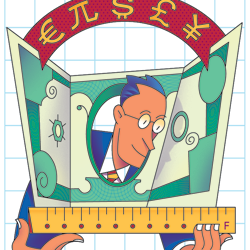 |
 Candy Adams,
Candy Adams,
CTSM, CME,
CEM, CMP, CMM,
"The Booth Mom,"
is an independent exhibit-management
consultant, trainer, speaker, writer, and an Exhibitor conference
faculty member.
CandyAdams
@BoothMom.com |
| |
 ou've finally convinced your management team that your booth is outdated and it's time for a new exhibit. You've got a budget, and you've narrowed the field to a shortlist of exhibit companies that you would like to consider for your project. ou've finally convinced your management team that your booth is outdated and it's time for a new exhibit. You've got a budget, and you've narrowed the field to a shortlist of exhibit companies that you would like to consider for your project.
Now your work really begins. It's time to start compiling information for a comprehensive request for proposal (RFP). This is the document you will send out to multiple exhibit designers and builders and/or exhibit houses to provide them with enough information to put together a design proposal for your new exhibit.
As you develop the RFP, put yourself in the shoes of your designer or exhibit house. Make sure you give them enough information to develop an exhibit concept that will truly meet your needs. Your complete RFP should include information in the following categories: company background, corporate exhibit program, service requirements, design requirements, budget information, and timeline.
Company Background
The RFP should tell the exhibit designer about your company and its "feel." To convey this information, attach your company's latest annual report, marketing and sales literature, current advertising campaigns, a press kit, and the URL to the company Web site. If your company has a style manual that calls out rules for logo, tag line, type font, and color use, include it as well.
Describe the different industries and markets to which you provide your products or services, including demographic and psychographic information. Include information about your company's market position, volume, and share, and any trends affecting your market position. Explain your products and services, your company's typical sales cycle, and some of your past exhibit promotions. Also list your competitors, discussing their comparative market share and your key differentiators.
Depending on the nature of the information you include, you may want to require RFP respondents to sign a non-disclosure agreement.
Corporate Exhibit Program
When the proposals come back, you should be able to evaluate each design based on how well it supports the marketing objectives you outlined, so thoroughly explain your corporate exhibit program from both a strategic and logistical level. Include a statement of the role that trade shows play in the company's overall strategic marketing plan, your trade show objectives, and the specific requirements of your show schedule.
Prioritize your objectives so the exhibit designer knows what the design is trying to accomplish. Common trade show objectives include sales objectives (e.g. generate a high volume or high quality of leads, meet with current customers or prospects), product objectives (e.g. introduce a new product or upgrade, show the breadth of a product line, etc.), communication objectives (e.g. spark product interest, educate prospects, gain press or media coverage, increase awareness, or enhance your brand presence), and distribution objectives (e.g. recruit distributors, or provide dealer support).
If any upcoming shows have major deviations from your usual objectives, point them out. Explain how, if at all, the exhibit needs to change from show to show, depending on your target audience. Are most of your shows targeted to horizontal or vertical markets? Does the exhibit need to be flexible, with multiple configurations for different-sized booth spaces? Will the exhibit be used in any other settings, such as in your corporate lobby, at shareholders meetings, hospitality events, or sales meetings?
Service Requirements
Specify which services you want your exhibit house to provide. Services available through full-service exhibit houses typically include exhibit design, exhibit construction, in-house graphics production, turnkey services, on-site supervision by your account executive or construction supervisor (generally included in the cost of setup at the exhibit's first show), material handling while in the exhibit house's warehouse, rental of ancillary furnishings, and exhibit-property inventory control and storage.
Ask for a rate sheet of the pricing structure for each of the exhibit house's services. This will tell you which services are billed at a flat rate, hourly rate, percentage markup, or by weight or volume. Also ask what is handled in-house and what is subcontracted. If you require a custom exhibit and the exhibit house does not maintain a shop to construct exhibits in house, find out who its vendors are and where they are located.
Design Requirements
Briefly outline the strengths and weaknesses of past exhibits, pointing out any elements of past exhibits that you want to repeat with this new exhibit. Also indicate if you have existing properties that you'd like to integrate into a new design, such as a hanging sign or reception counter. Many exhibit houses are masters of disguise and can save you money by upgrading pieces of your current exhibit.
Identify any atypical requirements imposed by show management at shows on your schedule, such as ceiling height; electrical, fire, and lighting codes; and sightline rules. These requirements can vary from show to show, often based on type of venue.
Explain any specific corporate mandates for the design of the booth, and identify the emotions you want attendees to feel when they see your exhibit. Do you want sharp and angular forms that say, "I'm strong and stable," or soft and curved shapes that say, "We're friendly, come on in!"? Do you want an open feel or the mystique of a more enclosed environment?
Provide details about each of the components your exhibit needs to contain. (Visit www.ExhibitorWebLinks.com for a full list of possible elements and information to include for each.)
Also specify what information you would like the exhibit company to include in its proposal. I typically ask for renderings of the exhibit, descriptions of its overall appearance, a list and samples of all materials and finishes that will be used, a list of components of the basic exhibit structure (including outside skin, mode of fasteners, and any creative features used in the construction of the exhibit), the estimated weight of the exhibit, and information regarding the durability and refurbishment needs of the property.
Budget Information
Some exhibit managers believe revealing your total budget gives designers free reign to go hog wild up to the budget number you provide. Others believe that the exhibit houses need all the information they can get to provide you with their best design with your needs and budget in mind. I lean more toward full disclosure of budget information, or at least giving a 90-percent figure so I still have a few pennies left for last-minute requests and upgrades. You can also provide a budget range.
Since very few RFPs are evaluated without regard for price, it's probably unfair to ask an exhibit house to design a booth for you without giving it any idea how much you're realistically willing to spend. Bottom line, be up front and indicate if your analysis of the proposals and final selection will be based primarily on design, functionality, or price. And since you'll be comparing different designs with different price tags, requesting a line-item budget will help you avoid an apples-to-oranges comparison.
To avoid this problem, you can also be specific about the items and services you want included in the final proposal, such as exhibit design and production drawings, construction (including all labor, materials, and fees), drawings and setup instructions for multiple configurations, an on-site exhibit preview, project-management, elements (e.g. towers, walls, and meeting or storage rooms), furnishings, hanging signs, flooring, graphics, lighting, audiovisual equipment, computer equipment, crates or cases, gang box and supplies, taxes on materials and labor, exhibit-house supervision of setup at first show (and cost of subsequent on-site supervision of I&D), ongoing cost of ownership (including general maintenance/refurbishment, storage, warehouse handling, and graphics upgrades), and so on.
To calculate the long-term costs of the proposed exhibit design, request an estimate of the total number of hours for I&D labor. In addition to I&D, there may be specialized labor and equipment hours to consider.
Also ask about payment terms and when deposits and progress payments will be due, and find out the costs of each of your ownership options, which may include renting, renting with an option to buy, leasing, and purchasing outright. Your accounting department will be able to guide you through this part of your RFP, depending on whether it wants to capitalize the exhibit properties or expense them. If capitalized, you'll need to work with accounting to determine the "life" of your exhibit for depreciation purposes, which is usually three or five years.
Timeline
Your RFP should include a timeline of any upcoming dates, such as your proposal deadline (don't forget to specify to whom completed proposals are to be submitted), exhibit-house presentation dates, the decision date for choosing the proposal winner, estimated dates for contract negotiations and signing, deposit dates, project-progress meeting dates, the final walk-through date, an estimated ship date, show setup dates, and hours and dates of the show at which the new exhibit will make its debut.
RFP Ethics
Give all bidders the same information, the same timeframe, and a fair chance to win your business. Unless stated otherwise in your RFP, bidders are generally given only one opportunity to respond to the RFP with their best design and price; accepting re-bids from select bidders isn't fair to the other companies involved in your RFP.
After you have selected an exhibit house, be courteous and notify those who didn't win your business. If they ask, let them know in non-specific terms why they didn't win, such as initial cost, design, materials, flexibility to various configurations, or cost effectiveness to maintain. This information may help them hone their proposal for the next exhibitor.
Finally, remember that the creative ideas generated by designers are copyrighted. An exhibit company's designs are its intellectual property, and stealing concepts from unaccepted proposals is unethical.
While the RFP process can be - and usually is - a daunting experience, a good RFP will pave the way for as smooth a process as possible. So take the time to prepare a thorough and comprehensive RFP that includes the preceeding information, and you'll thank yourself later. e
|
|
Ask and You Shall Receive
If your exhibit has to have specific elements, list them in the design requirements section of your RFP, along with information to help exhibit houses design a booth to meet your needs.
Product/Service Displays.
Provide a list of products and/or services you need the exhibit to display, along with the dimensions of each product. If you want to display multiple products, should they be grouped or shown individually on a wall or in a showcase? Do your products require power or network connectivity to work?
Demonstration Areas.
Do you need demonstration kiosks, computers, or other special equipment (such as cooling fans or extra power) to demonstrate your products? Do your presenters require microphones and small speakers at their demo stations? How much space do you need at each demonstration area, including space for visitor viewing?
Live Presentations.
If you want to include formal presentations, indicate what type of audiovisual equipment is required, whether you need a raised stage, how many attendees you expect at each presentation, and any other special requirements.
Meeting Rooms.
Indicate the number of meeting rooms you need, the number of people they need to hold, the level of privacy needed, and any furniture and AV requirements. If your exhibit has meeting rooms, do you need a lounge area for visitors and staff who are waiting for their meetings to begin? Will you need an area for snacks and beverages in the lounge area?
Information/Reception Center.
If you would like a central information center or reception desk, identify the main function of the desk and any special requirements, such as space allotted for lead-gathering equipment, giveaway distribution, literature, signage, or computers.
Storage.
What, if anything, do you need to be able to store in your exhibit, such as literature, giveaways, product samples, or staffers' personal items?
Lead-Gathering Area.
Do you need a place to house lead-gathering equipment? If so, include the size, electrical and networking requirements, and location of this equipment.
Literature Distribution.
Where and how will you distribute literature in your exhibit? Where is excess literature stored during the trade show?
Traffic Patterns.
Is there a specific sequence you would like attendees to follow in your exhibit, such as sitting through a live presentation, being routed to a lead-gathering site, and then released into the general demo area? Do attendees need to see your company's service process in a sequential order to have it make sense?
Graphics and Signage.
Identify any specific graphics and signage you want in your exhibit, such as a hanging sign above your exhibit, including your preference for materials and types of signs. Should the graphics be one-time use, easily changeable for multiple shows, or can they stay the same for each show?
Lighting.
Indicate if you would like specialized lighting such as overhead theatrical lighting, spotlights, wall washes, moving lighting, or projected images such as gobos.
Specialty Flooring.
Don't forget to include your preferences for flooring type, color, and pattern. Also indicate whether or not you want to use floor space to display corporate or product logos or messaging (either cut into the carpet or using gobos).
|





 ou've finally convinced your management team that your booth is outdated and it's time for a new exhibit. You've got a budget, and you've narrowed the field to a shortlist of exhibit companies that you would like to consider for your project.
ou've finally convinced your management team that your booth is outdated and it's time for a new exhibit. You've got a budget, and you've narrowed the field to a shortlist of exhibit companies that you would like to consider for your project.


